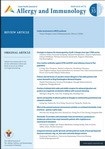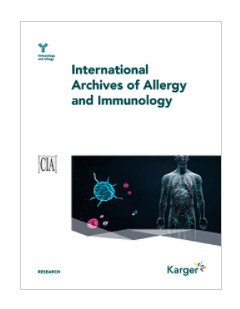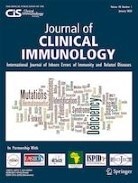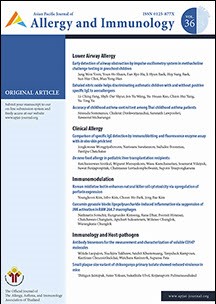
Association of HLA genotypes with Beta-lactam antibiotic hypersensitivity in children (2021)
Title : Association of HLA genotypes with Beta-lactam antibiotic hypersensitivity in children
Researcher : Clin.Prof.Suwat Benjaponpitak
Department : Faculty of Medicine, Siam University, Bangkok, Thailand
E-mail : med@siam.edu
Abstract : Background: Beta-lactam (BL) antibiotics hypersensitivity is common in children. Clinical manifestation of BL hypersensitivity varies from mild to severe cutaneous adverse drug reactions (SCARs).
Objective: To determine the association of HLA genotype and BL hypersensitivity and the prevalence of true drug allergy in patients with history of BL hypersensitivity.
Methods: A case-control study was performed in 117 children with aged 1-18 years. Children with history of non-SCARs BL hypersensitivity were evaluated for true drug hypersensitivity including skin test and drug provocation test. Tolerant control patients were children who could tolerate BL for at least 7 days without hypersensitivity reaction. HLA genotype (HLA-A, HLA-B, HLA-C and HLA-DRB1) were performed in 24 cases and 93 tolerant controls using PCR-SSO (polymerase chain reaction – sequence specific oligonucleotide probes).
Results: There were association of HLA-C*04:06 (OR = 13.14, 95%CI: 1.3-137.71; p = 0.027), and HLA-C*08:01 (OR = 4.83, 95%CI: 1.93-16.70; p = 0.016) with BL hypersensitivity. HLA-B*48:01 was strongly associated with immediate reaction from BL hypersensitivity (OR = 37.4, 95%CI: 1.69-824.59; p = 0.016) while HLA-C*04:06, HLA-C*08:01 and HLA-DRB1*04:06 were associated with delayed reaction (p < 0.05). Among 71 cases who were newly evaluated for BL hypersensitivity, only 7 cases (9.8%) had true BL hypersensitivity.
Conclusions: Less than 10% of children with suspected of BL hypersensitivity have true hypersensitivity. There might be a role of HLA-B, HLA-C and HLA-DRB1 genotype in predicting BL hypersensitivity in Thai children.
Link to Academic article: Asian Pacific Journal of Allergy and Immunology, 2021, 39(3), pp. 197–205. DOI: 10.12932/AP-271118-0449
Journal : Asian Pacific journal of allergy and immunology / in Scopus
Citation : Singvijarn, P., Manuyakorn, W., Mahasirimongkol, S., Wattanapokayakit, S., Inunchot, W., Wichukchinda, N., Suvichapanich, S., Kamchaisatian, W., & Benjaponpitak, S. (2021). Association of HLA genotypes with Beta-lactam antibiotic hypersensitivity in children. Asian Pac J Allergy Immunol. 39(3), 197–205. doi: 10.12932/AP-271118-0449. Epub ahead of print. PMID: 31012593.

Association of HLA genotypes with phenytoin induced severe cutaneous adverse drug reactions in Thai children (2020)
Title : Association of HLA genotypes with phenytoin induced severe cutaneous adverse drug reactions in Thai children
Researcher : Clin.Prof.Suwat Benjaponpitak
Department : Faculty of Medicine, Siam University, Bangkok, Thailand
E-mail : med@siam.edu
Abstract : Purpose: Phenytoin (PHT) is a common causative drug for severe cutaneous adverse drug reactions (SCARs) in children. SCARs, including drug reaction with eosinophilia and systemic symptoms (DRESS), Stevens-Johnson syndrome (SJS) and toxic epidermal necrolysis (TEN), are associated with a variation in HLA genotypes. Blood screening for specific HLA allele before PHT prescription would help in the reduction of the incidence of PHT induced SCARs. This study was to investigate the association between variations of HLA genotypes and PHT induced SCARs in Thai children.
Methods: Cases were Thai children aged between 0-18 years diagnosed with SCARs from PHT. Control groups were Thai children of corresponding age who had taken PHT for a least 12 weeks without any hypersensitivity reaction and healthy population controls. Blood samples from both groups were collected for HLA genotyping using a reverse-sequence specific oligonucleotide (SSO) probes method. Carrier rates of HLA alleles were compared between 22 cases (17 DRESS and 5 SJS-TEN), 60 tolerant controls and 649 population controls.
Results: Two HLA alleles includingHLA-B*51:01 and HLA-C*14:02 were significantly associated with PHT induced DRESS (OR 5.83; 95 % CI 1.36-25.00, p = 0.022 and OR 5.85; 95 % CI 1.16-29.35, p = 0.039). HLA-B*38:02 was significantly associated with PHT induced SJS-TEN (OR12.67; 95 % CI 1.50-106.89, p = 0.044). Haplotype analysis demonstrated the association of HLA haplotype A*11:01-B*51:01-C*14:02 and PHT induced DRESS compared to tolerant controls and the healthy population control group (OR 8.92; 95 % CI 1.47-54.02, p = 0.019, and OR 10.2; 95 % CI 3.04-34.21, p = 0.002). HLA haplotype B*38:02-C*07:01 in PHT induced SJS-TEN was significantly higher than those in tolerant controls and the healthy population control group (40 % vs 3.3 % vs 0.3 %; OR 19.33; 95 % CI 1.98-188.59, p = 0.027 and OR 215.67; 95 % CI 22.40-2076.04, p = 0.0003. HLA-B*15:02 was not associated with PHT induced SCARs.
Significance: An association betweenHLA-B*51:01 and HLA-C*14:02 and PHT induced DRESS and HLA-B*38:02 and PHT induced SJS-TEN has been demonstrated in Thai children.
Keywords: Drug reaction; HLA-B*38:02; HLA-B*51:01; HLA-C*14:02; Phenytoin.
Link to article : Epilepsy Research, 2020, 162, 106321. DOI: 10.1016/j.eplepsyres.2020.106321
Journal : Epilepsy Research Volume 162, May 2020,
Bibliography : Manuyakorn, W., Likkasittipan, P., Wattanapokayakit, S., Suvichapanich, S., Inunchot, W., Wichukchinda, N., Khongkhatithuml, C., Thampratankul, L., Kamchaisatian, W., Benjaponpitak, S., & Mahasirimongkol, S. (2020, May). Association of HLA genotypes with phenytoin induced severe cutaneous adverse drug reactions in Thai children. Epilepsy Res, 162, 106321. doi: 10.1016/j.eplepsyres.2020.106321. Epub 2020 Mar 13. PMID: 32272329.

Blood Coagulation and Asthma Exacerbation in Children (2016)
Title : Blood Coagulation and Asthma Exacerbation in Children
Researcher : Clin.Prof.Suwat Benjaponpitak
Department : Faculty of Medicine, Siam University, Bangkok, Thailand
E-mail : med@siam.edu
Abstract : Background: Recent studies have demonstrated the activation of coagulation pathways in asthmatic airways. This study aimed to determine systemic blood coagulation during asthma exacerbation compared with the stable state in children.
Methods: Pediatric patients (aged between 5 and 15 years) suffering from asthma exacerbation were enrolled. von Willebrand factor (vWF), plasminogen activator inhibitor type-1 (PAI-1), protein C, D-dimer, prothrombin fragment 1 + 2 (F1 + 2), thrombin-antithrombin complex (TAT), and C-reactive protein (CRP) levels were measured during asthma exacerbation and stable state.
Results: A total of 22 patients were enrolled. The median vWF, PAI-1, and CRP during asthma exacerbation were significantly higher than those of the stable state: 147.5% (interquartile range, IQR: 111.05-196.57) versus 94% (IQR: 69.72-109.62, p < 0.001), 41.9 ng/ml (IQR: 21.91-48.61) versus 26.17 ng/ml (IQR: 15.89-34.44, p < 0.03), and 4.46 mg/l (IQR: 2.15-16.23) versus 0.87 mg/l (IQR: 0.20-3.89, p < 0.015), respectively. However, the median protein C during asthma exacerbation was significantly lower than that of the stable state: 99.5% (IQR: 86.75-117) versus 113% (IQR: 94-115.25), p = 0.01. No significant difference was found between the levels of D-dimer, F1 + 2, and TAT during asthma exacerbation and stable state. Ultimately, D-dimer was positively correlated with asthma exacerbation score (R = 0.466, p = 0.027). A significant correlation was observed between vWF and CRP (R = 0.527, p = 0.012).
Conclusion: Evidence was found of increased endothelial activation and increased PAI-1 during asthma exacerbation. This may emphasize the potential role of blood coagulation in asthma exacerbation.
Link to Academic article: https://www.karger.com/Article/FullText/446775
Journal : International Archives of Allergy and Immunology Vol. 170, No. 2, 2016
Bibliography : Manuyakorn, W., Mairiang, D., Sirachainan, N., Kadegasem, P., Kamchaisatian, W., Benjaponpitak, S., & Chuansumrit, A. (2016). Blood coagulation and asthma exacerbation in children. Int Arch Allergy Immunol, 170(2), 75-83. doi: 10.1159/000446775.

Clinical practice guideline for diagnosis and management of urticaria (2016)
Title : Clinical practice guideline for diagnosis and management of urticaria
Researcher : Clin.Prof.Suwat Benjaponpitak
Department : Faculty of Medicine, Siam University, Bangkok, Thailand
E-mail : med@siam.edu
Abstract : Urticaria is a common skin condition that can compromise quality of life and may affect individual performance at work or school. Remission is common in majority of patients with acute spontaneous urticaria (ASU); however, in chronic cases, less than 50% had remission. Angioedema either alone or with urticaria is associated with a much lower remission rate. Proper investigation and treatment is thus required. This guideline, a joint development of the Dermatological Society of Thailand, the Allergy, Asthma, and Immunology Association of Thailand and the Pediatric Dermatological Society of Thailand, is graded and recommended based on published evidence and expert opinion. With simple algorithms, it is aimed to help guiding both adult and pediatric physicians to better managing patients who have urticaria with/without angioedema. Like other recent guideline, urticaria is classified into spontaneous versus inducible types. Patients present with angioedema or angioedema alone, drug association should be excluded, acetyl esterase inhibitors (ACEIs) and non-steroidal anti-inflammatory drugs (NSAIDs) in particular. Routine laboratory investigation is not cost-effective in chronic spontaneous urticaria (CSU), unless patients have clinical suggesting autoimmune diseases. Non-sedating H1-antihistamine is the first-line treatment for 2-4 weeks; if urticaria was not controlled, increasing the dose up to 4 times is recommended. Sedating first-generation antihistamines have not been proven more advantage than non-sedating antihistamines. The only strong evidence-based alternative regimen for CSU is an anti-IgE: omalizumab; due to very high cost it however might not be accessible in low-middle income countries. Non-pharmacotherapeutic means to minimize hyper-responsive skin are also important and recommended, such as prevention skin from drying, avoidance of hot shower, scrubbing, and excessive sun exposure.
Link to Academic article: https://pubmed.ncbi.nlm.nih.gov/27690471/
Journal : Asian Pacific journal of allergy and immunology Volume 34 Number 3 September 2016
Bibliography : Kulthanan, K., Tuchinda, P., Chularojanamontri, L., Chanyachailert, P., Korkij, W., Chunharas, A., Wananukul, S., Limpongsanurak, W., Benjaponpitak, S., Wisuthsarewong, W., Aunhachoke, K., Wessagowit, V., Chatchatee, P., Wattanakrai, P., Jirapongsananuruk, O., Klaewsongkram, J., Noppakun, N., Vichyanond, P., Suthipinittharm, P., Ruxrungtham, K., Singalavanija, S., & Ngamphaiboon, J. (2016). Clinical practice guideline for diagnosis and management of urticaria. Asian Pac J Allergy Immunol, 34(3), 190-200.

Compound Heterozygous PGM3 Mutations in a Thai Patient with a Specific Antibody Deficiency Requiring Monthly IVIG Infusions (2020)
Title : Compound Heterozygous PGM3 Mutations in a Thai Patient with a Specific Antibody Deficiency Requiring Monthly IVIG Infusions
Researcher : Clin.Prof.Suwat Benjaponpitak
Department : Faculty of Medicine, Siam University, Bangkok, Thailand
E-mail : med@siam.edu
Link to Academic article: DOI: 10.1007/s10875-019-00693-6
Journal : Journal of Clinical Immunology Vol. 40, No. 1, 2020
Bibliography : Ittiwut, C., Manuyakorn, W., Tongkobpetch, S., Benjaponpitak, S., Fisher, M. R., Milner, J. D., Lyons, J. J., Suphapeetiporn, K., & Shotelersuk, V. (2020, January). Compound Heterozygous PGM3 Mutations in a Thai Patient with a Specific Antibody Deficiency Requiring Monthly IVIG Infusions. J Clin Immunol, 40(1), 227-231. doi: 10.1007/s10875-019-00693-6. Epub 2019 Nov 9. PMID: 31707513.

De novo food allergy in pediatric liver transplantation recipients (2018)
Title : De novo food allergy in pediatric liver transplantation recipients
Researcher : Clin.Prof.Suwat Benjaponpitak
Department : Faculty of Medicine, Siam University, Bangkok, Thailand
E-mail : med@siam.edu
Abstract : Background: Food allergy (FA) prevalence is increasing in pediatric liver transplantation (LT). However, the clinical course is still limited.
Objective: This retrospective cohort study aimed to identify the prevalence, risk factors, and the natural history of de novo FA in children post LT.
Methods: Medical records of pediatric LT recipients from Jan 2001 – Dec 2014 were reviewed. De novo FA was diagnosed by symptoms after exposure to culprit food occurring after LT, and improvement after diet elimination. FA was confirmed if reproduced symptoms after re-challenge or documented sensitization or indicated gastrointestinal eosinophilia.
Results: Among 46 post LT children, 54.3% developed de novo FA at a median time of 12.2 months [Interquartile range (IQR) 6.2, 21.3 months] post LT. The confirmed FA was 39.1%. Gastrointestinal symptom was the most common manifestation followed by skin, anaphylaxis, and others. Culprit foods were cow’s milk, shellfish, egg, wheat, soybean, peanut, coconut, fish and monosodium glutamate. The risk factors of FA were transplantation during age below 2 years [hazard ratio (HR), 2.62; 95% confidence interval (CI), 1.04 – 6.59; p = 0.03), atopic history in family (HR, 5.67; 95% CI, 1.33 – 24.12; p = 0.01), and Epstein-Barr (EBV) viremia (HR, 2.39; 95% CI, 1.02 – 5.63; p = 0.04).
Conclusions: de novo FA in pediatric LT is not uncommon. Age at LT younger than 2 years, family history of atopy, and EBV viremia are associated with developing FA. Development of tolerance after elimination culprit diets for 3 years is similar to general population.
Key words: Food allergy, liver transplantation, tolerance, outgrown, de novo food allergy
Link to Academic article: DOI: 10.12932/AP-080217-0007
Journal : Asian Pacific journal of allergy and immunology
Bibliography : Sinitkul, R., Manuyakorn, W., Kamchaisatian, W., Vilaiyuk, S., Benjaponpitak, S., Lertudompholwanit, C., & Treepongkaruna, S. (2018, September). De novo food allergy in pediatric liver transplantation recipients. Asian Pac J Allergy Immunol, 36(3), 166-174. doi: 10.12932/AP-080217-0007. PMID: 29161056.

Effect of vitamin D on lung function assessed by forced oscillation technique in asthmatic children with vitamin D deficiency: A randomized double-blind placebo-controlled trial (2019)
Title : Effect of vitamin D on lung function assessed by forced oscillation technique in asthmatic children with vitamin D deficiency: A randomized double-blind placebo-controlled trial
Researcher : Clin.Prof.Suwat Benjaponpitak
Department : Faculty of Medicine, Siam University, Bangkok, Thailand
E-mail : med@siam.edu
Abstract : Background: The role of vitamin D and asthma in pulmonary function changes showed conflicting result.
Objective: To evaluate if vitamin D treatment would improve lung function assessed by forced oscillation technique (FOT) in vitamin D deficient asthmatic children.
Methods: A randomized double-blind placebo-controlled trial was performed in children, aged 3-18 years with well controlled asthma. Serum total 25(OH)D and FOT parameters including respiratory resistance at 5 Hz (R5), at 20 Hz (R20), respiratory reactance at 5 Hz (X5) and area of reactance (ALX), resonance frequency (Fres) were evaluated at baseline, 1 month and 3 months. Vitamin D deficient patients (serum total 25(OH)D < 20 ng/ml) were randomized to receive treatment with vitamin D2 (tVDD) or placebo (pVDD). Non-vitamin D deficient patients (nVDD) received placebo as a control group.
Results: A total of 84 children were recruited, 43 patients in nVDD group, 20 in tVDD group and 21 in pVDD group. There were no significant differences in age, sex, height and weight among groups. There were no significant differences of FOT parameters among groups at all visits. There was a trend toward decrease in R5/R20 from baseline to 1 month and 3 months visit in all groups, but the statistically significant improvement was observed only in nVDD group. Serum 25(OH)D showed no correlation with % predicted of FOT measures.
Conclusion: Vitamin D treatment in asthmatic children who had vitamin D deficiency may have no short term beneficial effect on pulmonary function assessed by FOT. Vitamin D supplementation in all asthmatic patient needs further study.
Link to Academic article: DOI: 10.12932/AP-010519-0553
Journal : Asian Pacific journal of allergy and immunology
Bibliography : Swangtrakul, N., Manuyakorn, W., Mahachoklertwattana, P., Kiewngam, P., Sasisakulporn, C., Jotikasthirapa, W., Kamchaisatian, W., & Benjaponpitak, S. (2019, December 14). Effect of vitamin D on lung function assessed by forced oscillation technique in asthmatic children with vitamin D deficiency: A randomized double-blind placebo-controlled trial. Asian Pac J Allergy Immunol, doi: 10.12932/AP-010519-0553. Epub ahead of print. PMID: 31837209.

Favorable Response to Interferon-α in Infantile-onset Idiopathic Hypereosinophilic Syndrome Complicated by Status Epilepticus During Treatment (2021)
Title : Favorable Response to Interferon-α in Infantile-onset Idiopathic Hypereosinophilic Syndrome Complicated by Status Epilepticus During Treatment
Researcher : Clin.Prof.Suwat Benjaponpitak
Department : Faculty of Medicine, Siam University, Bangkok, Thailand
E-mail : med@siam.edu
Link to Academic article: DOI: 10.1097/MPH.0000000000002052
Journal : Journal of Pediatric Hematology/Oncology Published Ahead-of-Print
Bibliography : Kanchongkittiphon, W., Kittinon, K., Wanitchakorn, A., Benjaponpitak, S., & Manuyakorn, W. (2021, January 11). Favorable Response to Interferon-α in Infantile-onset Idiopathic Hypereosinophilic Syndrome Complicated by Status Epilepticus During Treatment. J Pediatr Hematol Oncol, doi: 10.1097/MPH.0000000000002052. Epub ahead of print. PMID: 33448715.

Forced oscillation technique as a predictor for loss of control in asthmatic children (2020)
Title : Forced oscillation technique as a predictor for loss of control in asthmatic children
Researcher : Clin.Prof.Suwat Benjaponpitak
Department : Faculty of Medicine, Siam University, Bangkok, Thailand
E-mail : med@siam.edu
Abstract : Background: A reliable objective tool using as a predictor of asthma control status could assist asthma management.
Objective: To find the parameters of forced oscillation technique (FOT) as predictors for the future loss of asthma symptom control.
Methods: Children with well-controlled asthma symptom, aged 6-12 years, were recruited for a 12-week prospective study. FOT and spirometer measures and their bronchodilator response were evaluated at baseline. The level of asthma symptom control was evaluated according to Global Initiative for Asthma.
Results: Among 68 recruited children, 41 children (60.3%) maintain their asthma control between 2 visits (group C-C), and 27 children (39.7%) lost their asthma control on the follow-up visit (group C-LC). Baseline FOT parameters, including the values of respiratory resistance at 5 Hz (R5), respiratory resistance at 20 Hz (R20), respiratory reactance at 5 Hz, area of reactance, %predicted of R5 and percentage of bronchodilator response (%∆) of R5 and R20 were significantly different between C-C and C-LC groups. In contrast, only %∆ of forced vital capacity, forced expiratory volume in 1 second (FEV1), and FEF25%-75% (forced expiratory flow 25%-75%) were significantly different between groups. Multiple logistic regression analysis revealed that %predicted of R5, %∆R5, %predicted of FEV1 and %∆FEV1 were the predictive factors for predicting the future loss of asthma control. The following cutoff values demonstrated the best sensitivity and specificity for predicting loss of asthma control: %predicted of R5=91.28, %∆R5=21.2, %predicted of FEV1=89.5, and %∆FEV1=7.8. The combination of these parameters predicted the risk of loss of asthma control with area under the curve of 0.924, accuracy of 83.8%.
Conclusion: Resistance FOT measures have an additive role to spirometric parameter in predicting future loss of asthma control.
Keywords: Asthma; Frequency of resonance; Reactance; Resistance; Spirometry.
Link to Academic article: DOI: 10.5415/apallergy.2020.10.e3
Journal : Asia Pacific Allergy Vol.10 No.1 (2020)
Bibliography : Kreetapirom, P., Kiewngam, P., Jotikasthira, W., Kamchaisatian, W., Benjaponpitak, S., & Manuyakorn, W. (2020, January 17). Forced oscillation technique as a predictor for loss of control in asthmatic children. Asia Pac Allergy, 10(1), e3. doi: 10.5415/apallergy.2020.10.e3. PMID: 32099825; PMCID: PMC7016320.

Needle length for epinephrine prefilled syringes in children and adolescents: Is one inch needle appropriate? (2018)
Title : Needle length for epinephrine prefilled syringes in children and adolescents: Is one inch needle appropriate?
Researcher : Clin.Prof.Suwat Benjaponpitak
Department : Faculty of Medicine, Siam University, Bangkok, Thailand
E-mail : med@siam.edu
Abstract : Background: Intramuscular epinephrine is the first line drug in the treatment of anaphylaxis. This study was to identify the appropriateness of 1 inch needle length for epinephrine prefilled syringes in children.
Methods: Children aged 1 month to 18 years were enrolled. Skin to muscle depth (STMD) and skin to bone depth (STBD) were measured using an ultrasonography at the mid-anterolateral thigh. A 1 inch needle was considered as being appropriate if the STBD was more than 1 inch and the STMD was less than 1 inch.
Results: Seventy five infants, 75 pre-school aged children, 75 school aged children and 147 adolescent were enrolled: 196 (52.7%) children were male. A 1 inch needle length was appropriate for 61% of the infants, for 88% of the preschool children, for 99% of the school aged children and for 95% of the adolescents. Thigh circumference ≥23 cm, BMI ≥16 kg/m2 and BW ≥ 6 kg in infants provided the sensitivity of 74%-96% in predicting the appropriateness of 1 inch needle. In preschool group, thigh circumference ≥25 cm, BMI ≥13.5 kg/m2 and BW ≥ 10 kg provided the sensitivity of 98.5-100% in predicting the appropriateness of 1 inch needle. Thigh circumference ≥ 49 cm in adolescents provided the sensitivity of 75% in predicting that a 1 inch needle was too short.
Conclusion: One inch needle length may not be appropriated for intramuscular injection at thigh in all children. Thigh circumference, BMI and body weight are useful for predictor for using the 1 inch needle.
Key words: Anaphylaxis, children, epinephrine, needle length, intramuscular
Link to Academic article: DOI: 10.12932/AP-020317-0039
Journal : Asian Pacific journal of allergy and immunology
Bibliography : Manuyakorn, W., Bamrungchaowkasem, B., Ruangwattanapaisarn, N., Kamchaisatian, W., & Benjaponpitak, S. (2018, June). Needle length for epinephrine prefilled syringes in children and adolescents: Is one inch needle appropriate?. Asian Pac J Allergy Immunol, 36(2), 113-119. doi: 10.12932/AP-020317-0039. PMID: 28938839.